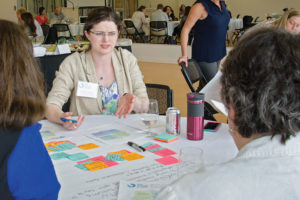
Have you or others you know ever hosted a program for teens and tweens that centers on making duct-tape wallets? Typically these programs provide youth with a set of materials—duct tape in many colors, glitter, scissors, stickers, instructions on how to make a duct-tape wallet—and then a staff person running the program might say something to the group like, “go for it.”
What if I said that that’s not how that program—or any library program—should work? By running a program in that way you aren’t really supporting youth learning. Imagine instead if you:
- Start by asking youth to talk with one another, in small groups or in a full group, about what they like and don’t like about their current wallets.
- Have the youth brainstorm ways—again, in small groups or as a full group—to improve their wallets.
- Ask members of the group to sketch ideas for a new wallet and present their sketches to others for feedback.
- Have the youth create prototypes of wallets based on these sketches.
- Have the youth test the wallets through use.
- Gather feedback on the prototypes to revise and repeat prototyping and testing.
What is design thinking?
The process described above is a way that you can start integrating design thinking into library activities for youth. The idea is that, instead of simply providing the activity, you provide a framework for thinking about the activity. As a result, you help youth develop skills such as critical thinking, problem solving, and collaboration; college and career readiness; and social and emotional learning. Social and emotional learning is evident because the process requires learning about—and empathizing with—others’ needs. Design thinking can also support information literacy skills, as youth may take part in research activities as a part of the overall process.
While the steps in design thinking may vary based on the exact model you use, the basic flow is:
- Decide on a problem that needs solving. This decision making can happen through reading, conversation, and observation.
- Spend time learning about the problem through additional research, conversation, and observation.
- Brainstorm ways to solve the problem.
- Develop prototypes of potential solutions.
- Test the prototypes.
- Repeat the prototyping and testing phases.
Design thinking helps youth develop skills such as critical thinking, problem solving, and collaboration; college and career readiness; and social and emotional learning.
Design thinking to inspire initiatives
Not only can these steps effectively guide programs you sponsor for youth and families, design thinking can also help you make administrative decisions about youth services initiatives.
An example of how design thinking helps in organizational planning is visible in the KidsTeam project led by University of Washington Information School (UW iSchool) Assistant Professor Jason Yip and Juan Rubio, digital media and learning program manager at Seattle Public Library. Yip and Rubio work with kids to develop learning experiences, and in their project they learn from their users by prototyping and testing solutions as the youth try out and provide feedback on activities.
“Kids are full of ideas that would escape you as an adult,” Rubio noted in a recent UW iSchool news feature. “I am always surprised at their imagination, creativity, and fresh look at things. Since I am creating programs with them in mind, it is extremely valuable to involve them in the design of their learning.”
Design thinking can help you build out your youth programs to support youth learning. To learn more, check out the “Design Thinking for Libraries” and “Design Thinking for Educators” toolkits. Also, don’t miss “Design Thinking Projects and Challenges” from Stanford’s d.school.



Thank you for the good post!
I definitely agree, there are lots of fresh ideas coming from youth and collaborating with them or having them in team is one of the great idea that most companies do.
Thank you for this cool stuff! I believe that design thinking can be used successfully within any industry—not just tech or design.